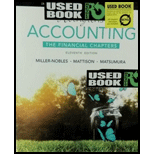
Concept Introduction
Profit Margin Ratio: Profit Margin Ratio is a financial profitability ratio that is used to compare a company’s net earnings and its net sales. It is calculated by dividing net income (or operating income) by net sales of a company for a particular period.
Return on Total Assets: Return on Total Assets (ROTA) is a financial profitability ratio that measures how effectively and efficiently a company utilizes its assets to generate profits during a period. It is calculated by dividing earnings before interest and tax (EBIT) by the average total assets for a particular period.
Asset Turnover Ratio: Asset Turnover Ratio is a financial efficiency ratio which is used to measure how efficiently a company is using its assets to generate sales. It is measured as the ratio of net sales to the average total assets of a company for a particular period.
Return on Common
Earnings per Share: Earnings per Share (EPS) is a financial profitability ratio that measures the amount of net income available to common stockholders earned on one share. It is calculated by dividing net income available to common stockholders by the average (or weighted average) number of shares outstanding during a period.
Dividend Payout Ratio: Dividend Payout Ratio is a financial ratio that shows the percentage of a company’s earnings that is paid in the form of dividends. It is calculated by dividing dividend per share by earnings per share (EPS) for a particular period.
Requirement 1
To Compute:
The profit margin ratio for 2017 and 2016.
Requirement 2
To Compute:
The
Requirement 3
To Compute:
The asset turnover ratio for 2017 and 2016.
Requirement 4
To Compute:
The rate of return on common stockholders’ equity for 2017 and 2016.
Requirement 5
To Compute:
The earnings per share for 2017 and 2016.
Requirement 6
To Compute:
The 2017 dividend payout on common stock.
Requirement 7
Whether the company’s operating performance improved or deteriorated during 2017.
Want to see the full answer?
Check out a sample textbook solution
Chapter 17 Solutions
Horngren's Accounting, The Financial Chapters (11th Edition) - Standalone Book
- The storekeeper at Charles Resort conducted the monthly cleaning supply inventory. Records showed an opening balance of 720 units, with deliveries of 310 units and consumption recorded at 650 units during the month. Physical verification found 365 units in stock. The operations manager requested the quantity variance report.arrow_forwardProvide answerarrow_forwardTorrance Industries has the following information concerning its direct materials:arrow_forward
- The gross margin for November isarrow_forwardI am searching for the correct answer to this general accounting problem with proper accounting rules.arrow_forwardBrookside Manufacturing provides the following information for their first year of operations in 2017: Sales, 6,200 units @ $12 each; Total production, 8,400 units; Selling and administrative costs: Fixed $1,200, Variable $1.50 per unit; Production costs per unit: Direct materials $2.50, Direct labor $3.00, Variable overhead $1.25, Fixed manufacturing overhead $10,080. Brookside Manufacturing uses absorption costing. Use this information to determine for Brookside Manufacturing the FY 2017: A. Cost of Goods Sold B. Net Incomearrow_forward

 AccountingAccountingISBN:9781337272094Author:WARREN, Carl S., Reeve, James M., Duchac, Jonathan E.Publisher:Cengage Learning,
AccountingAccountingISBN:9781337272094Author:WARREN, Carl S., Reeve, James M., Duchac, Jonathan E.Publisher:Cengage Learning, Accounting Information SystemsAccountingISBN:9781337619202Author:Hall, James A.Publisher:Cengage Learning,
Accounting Information SystemsAccountingISBN:9781337619202Author:Hall, James A.Publisher:Cengage Learning, Horngren's Cost Accounting: A Managerial Emphasis...AccountingISBN:9780134475585Author:Srikant M. Datar, Madhav V. RajanPublisher:PEARSON
Horngren's Cost Accounting: A Managerial Emphasis...AccountingISBN:9780134475585Author:Srikant M. Datar, Madhav V. RajanPublisher:PEARSON Intermediate AccountingAccountingISBN:9781259722660Author:J. David Spiceland, Mark W. Nelson, Wayne M ThomasPublisher:McGraw-Hill Education
Intermediate AccountingAccountingISBN:9781259722660Author:J. David Spiceland, Mark W. Nelson, Wayne M ThomasPublisher:McGraw-Hill Education Financial and Managerial AccountingAccountingISBN:9781259726705Author:John J Wild, Ken W. Shaw, Barbara Chiappetta Fundamental Accounting PrinciplesPublisher:McGraw-Hill Education
Financial and Managerial AccountingAccountingISBN:9781259726705Author:John J Wild, Ken W. Shaw, Barbara Chiappetta Fundamental Accounting PrinciplesPublisher:McGraw-Hill Education





